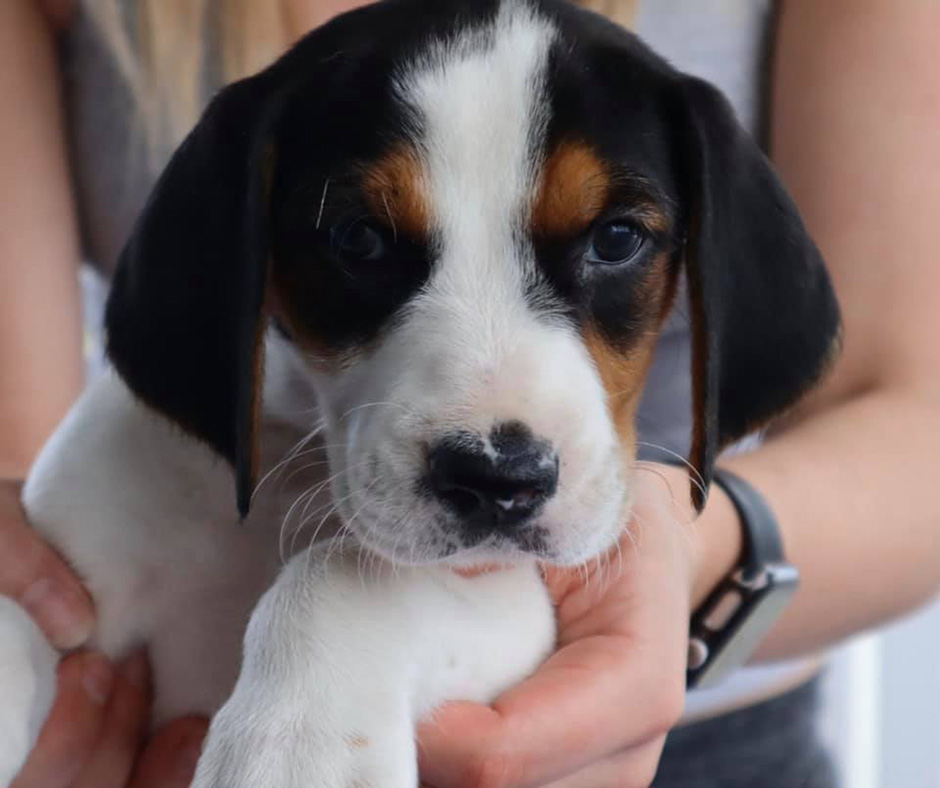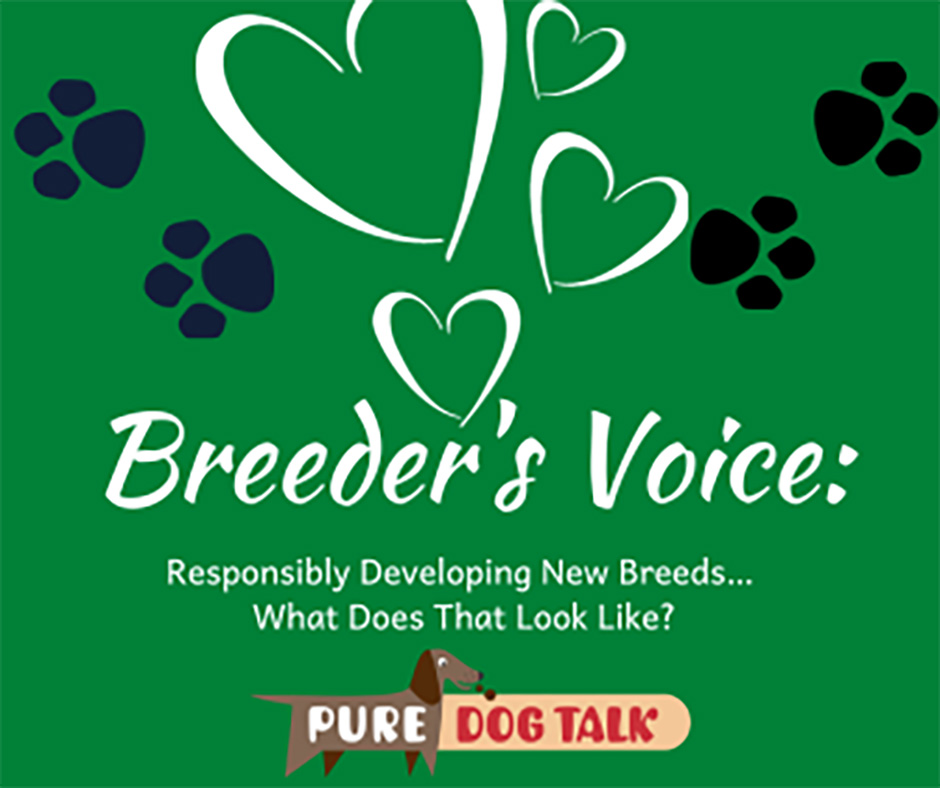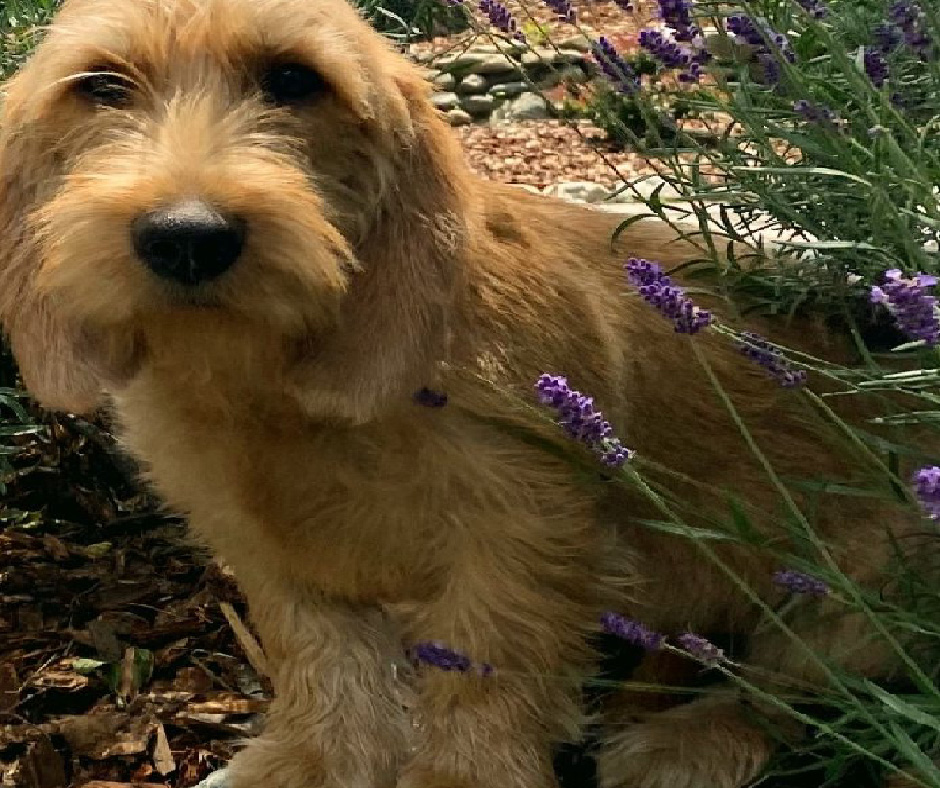Posts by Laura Reeves
607 – Keeping Foxhounds Alive Into the 21st Century
Keeping Foxhounds Alive Into the 21st Century

Brigette Bryson with one of her Foxhounds.
Brigette Bryson, second generation breeder of Foxhounds at Foxhunt Kennels in Australia, joins host Laura Reeves in a wide ranging conversation about English Foxhounds, preserving the history they represent and how she hopes to keep the breed alive into the 21st century.
There are three breeders of English Foxhounds listed on the US National Club website. In 2022, the breed dropped to last place in numbers of dogs registered with AKC. Although the breed lives on in the packs around the globe, their popularity has certainly faded from their heyday when hunting fox was both useful and fashionable in much of the world.
“I don’t know if that’s ever going to change dramatically,” Bryson said. “I have this conversation with people regularly. I don’t know that you can ever make them mainstream. Their history is so deep. And it’s entrenched in people’s brains that this is a hunting and a working breed that’s not gonna fit in my suburban backyard.
“So I don’t know if you can ever change that. My goal is just to see them survive. That will happen in the packs. There’s many packs. You know, we’re not gonna have a figure of how many dogs exist in those packs, but they’re there. And I think that they will always be there through people like me that have maybe grown up in that pack and they’re obsessed with the breed, so they’ll keep it going.
“What I would like to see is if we could have a few breeders in each country breeding them, that would be a success for me. It’s enough to keep them alive and not let that piece of history die for me. I think I really enjoy the history of the breed. I love that almost every kennel club you visit around the world is gonna have a painting of Foxhounds hunting. I think it’s important to maintain it for that reason.
“I of course would love to see them become more popular with the general public. I just don’t know if that’s possible. The sizes of houses and properties and everything, it’s gonna be the same problem for all large breeds. It’s getting smaller.
“And realistically, as much as you can raise them to live in a smaller environment, it’s not ideal for them and people would have to put in a lot more effort to meeting their energy needs. My goal is just to get them out there with breeders around the world. That’s what I’m trying to achieve now.
“There’s not a single registered breeder that has had a litter in the UK that I can think of in the last 10 years. We have one active registered breeder in New Zealand who’s fantastic. And there’s a few really healthy packs over there that have some dogs from us as well.
“And in America, there’s a handful if they even keep breeding, but they start aging out too. And that’s what’s happening here. There was four main breeders that we had, myself and my parents before me worked in with. One of those hasn’t bred a litter for a decade. And the other two are at the point where they’re saying to me, I don’t know if I’ll have any more just because they’re getting a bit older.
“And (Foxhounds) are incredibly healthy. Now that’s another one that’s complex. Foxhounds have been largely inbred since the beginning of time. But with that, only the strong survived. There is no hereditary diseases in the breed.
“Part of that is that there hasn’t been human intervention. So, all the debates that people have about inbreeding, and I have this debate with people regularly, because they’ll say to me, you’re gonna have to outcross. And I say, well, you need to outcross because you’ve got problems you need to fix.
“But if I don’t have any problems, why do I need to do that? A litter we had last year was from a six -year -old maiden bitch, 15 puppies. So, we’re not having those issues that other people have. They’re incredibly healthy. And people buying these dogs that they spend thousands and thousands and thousands of dollars trying to keep alive, I can sell you a Foxhound that will only have to go to the vet for its vaccinations.”
606 – Protecting Breeds Into the Future
Protecting Breeds Into the Future
Dr. Marty Greer, DVM joins host Laura Reeves to discuss AKC’s newest service for preservation breeders. Greer was actively involved in AKC’s development of the Purebred Preservation Bank, taking the idea from the Otterhound Club of America. We had the conversation with Joellen Gregory early on about the Otterhound’s semen bank, and AKC has taken this and developed it into something that’s available for all parent clubs.
“(PPB will allow) AKC to fund the long -term storage of semen that no longer has an owner that wants to manage it,” Greer said. “So, you don’t necessarily have to have passed away for this to happen. If you’re at the end of your breeding program and you’re sitting there with six beautiful dogs that have semen frozen, and you’re like, ‘Well, I don’t have anybody I’ve really mentored and my kids don’t want it, so where do I go with this?’
“That’s when you go to the AKC website, you pull up the information on there, you sign the document that allows AKC to take ownership. And once you hand it off, you no longer are in control of that part of the semen. You may send all of your dog’s semen, you may send part of that dog’s semen, you may send all the semen that you have to the AKC, and AKC will then pay for the long -term storage.
“Every breed club makes their own rules. Your parent club can put together their health committee, their genetics committee, a special committee for this. Your breed club will sit down and with some ideas from what other breed clubs have done, be able to say, ‘This is how we want the semen disseminated. Does the bitch have to have a CHIC number? Does she have to have these certain criteria? When is it appropriate to use? Has she had a litter before?’ All those kinds of things, your breed club can decide.
“But as you release the semen, you can’t say, ‘Well, I don’t like Susie Smith.” Susie Smith is never going to get to touch my semen ever, ever, as long as I live, over my dead body. Maybe it will be over your dead body because now it’s no longer yours.
“Fifty years from now and 100 years from now, that’s what we’re looking at. We’re not looking at what happens next Tuesday when a bitch has to be bred. We’re looking at 100 years from now. Is your dog still of value? You might say things like, ‘Well, styles of dogs change,’ and indeed they do. But sometimes those foundational dogs are structurally what you need. Sometimes those foundation dogs predate certain genetic disorders that have really worked their way deeply into the gene pool and could be very hard to breed your way out of.
“AKC’s role in this is to pay for the semen storage and to register the puppies. That’s it. AKC is not there to start saying, ‘Well, we want you to do this with this and we want you to do that with that. And you have to have faith that 100 years from now, this mission, this vision is going to be held true. But it’s not about Susie Smith. It’s not about you. It’s not about (any individual dog). It’s about the overall health of the breed and where we can go with some of the genetics.”
605 – LIVE Debate: Should Professional Handlers Be Allowed in BPUP?
LIVE Debate: Should Professional Handlers Be Allowed in BPUP?
Our final installation for Spicy October is a LIVE@5 debate between an owner handler and a professional handler regarding the hot topic of the rules around the BPUP, 4-6 months puppy competition.
Natalie Thurman, owner handler:
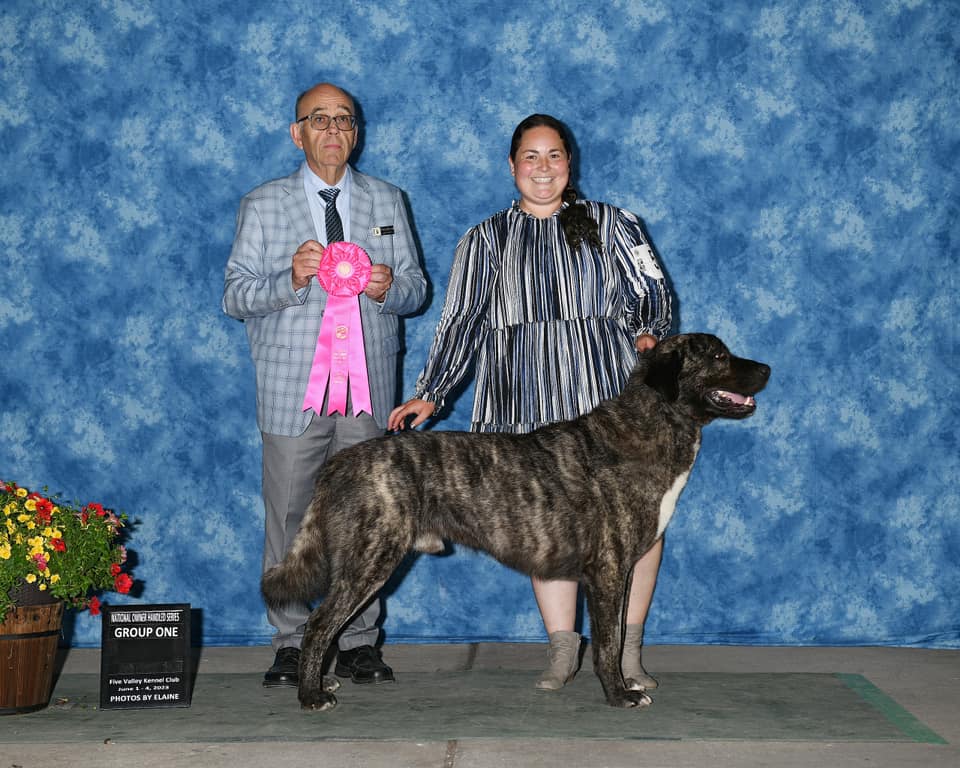
Natalie Thurman and Ares winning Owner Handled Group.
I do think that there are people who start out and it is intimidating to go up against the Laura’s and the Karyn’s of the world because you just make it look so easy and then we try to go do it and then it’s not as easy. Not even a little bit. I mean I know it’s why we have owner handled groups. But if you’re not getting to the owner handled group either BPUP could be a good place to feel safe as a non-experienced dog show human.
Karyn Cowdrey, professional handler:
I believe everyone should have the opportunity, including breeder owner handlers, to show in BPUP. Why? Because the fact of reality of our life today is there are fewer and fewer handling classes people can get to. As handlers, often we’re the ones teaching the handling class and we don’t get to work our dogs in the environment. As a handler, it is important to me that my puppies that I own, that I bred, that I decided to keep, get the best experience they can in the
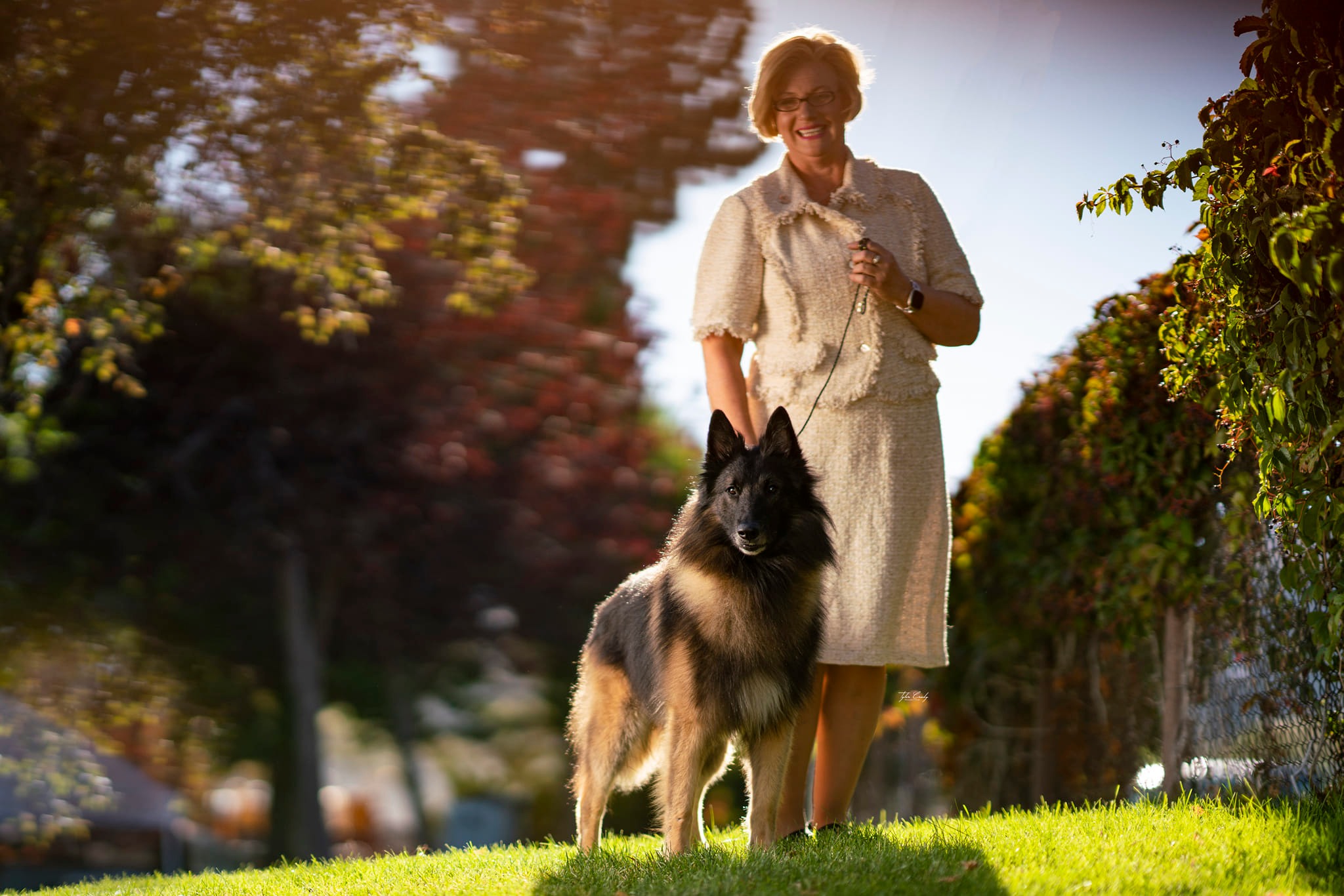
Karyn Cowdrey, BlackFyre Handling Services.
start of life in the ring. I shouldn’t have to hand them off to a total stranger.
Laura Reeves, host and moderator:
The concept (of BPUP) is that the American Kennel Club wants to support the novice handlers and that the simple presence of someone more capable than they are, whether they be a professional or a breeder or what have you, is unnerving. And I don’t know that that’s a great solution. I think we all learn by being challenged, but I know it is something that is a thing.
AKC gets banged a lot for not being encouraging and inviting and we as the representatives of the AKC get banged for the same thing. I sincerely believe that for people who think it is a big deal, they should get to do that. They should get to have that moment.
Hope is what gets us and keeps us. And I guess that’s what I would pin Best Puppy to. Is that baby inkling of hope. That tiny tingle of hope that the very new person gets when they get their first puppy.
And they are so excited and they don’t know what the hell they’re doing. And their breeder’s probably shoving them in the ring. And they’re really encouraging them to do this. It’s hope. And I guess to me, when I judge it, when I see it, best puppy to me represents hope. It represents the hope that we as breeders have for those puppies that are in the ring. It represents the hope that those owners and handlers have for their new puppies. It’s hope.
BPUP represents the hope that those owners and handlers have for their new puppies. It’s hope.
The part of me that thinks that hope is important, thinks that owner handled being what is important and encouraging new people being what’s important, I see the argument to make it a quote -unquote safe space from professionals.
Join us for the full replay of this spicy hot topic.
604 – Creating Better Outcomes for ALL Dogs
Creating Better Outcomes for ALL Dogs
Host Laura Reeves is joined by the founders of For All Dogs — Chris Fleming of Pinnacle Pet and Martha Boden of SPCA Tampa Bay. This unlikely partnership grew out of a mutual desire to create better outcomes for all dogs, including retired breeding dogs from commercial kennels and adoptable dogs in animal shelters.
As we wrap up “spicy October,” this conversation about a powerful alliance of opposing forces stands as a testament to the positive outcomes when we work together for the good of ALL dogs, instead of tearing one another down.
Fleming is a broker for commercial kennels who sell puppies through pet stores. Boden is the director SPCA Tampa Bay’s animal shelter. They describe their partnership and friendship as serendipitous. Their work is beyond groundbreaking.

Chris Fleming, CEO Pinnacle Pet
In 2008, Fleming began working with his suppliers to improve their facilities and programs. After meeting Dr. Candace Croney in 2014, he started encouraging these breeders to come into compliance with the Canine Care Certified program she created. Listeners may remember the episode linked HERE where Laura spoke with Dr. Croney about this program.
“So, the benefits from the Canine Care, it’s data that has been just really kind of eye -opening for us,” Fleming said. “Looking at taking notes, breeders do everything from measuring humidity and air temperatures every day to stimulation or handling the pups that they deal with, really puts in a more hands -on approach.
“What we’re seeing is better socialized animals. We’re seeing healthier moms. We’re seeing when you’re focused and attentive to what they’re doing, the happier mom makes a happier pup, you’re having lower vet bills and it feels weird saying this now because it feels like common sense but now it’s, I can point to the science of this. So lower vet bills, happier healthier moms and puppies and being mindful of an appropriate retirement age.
“You also have a kennel that you’re getting moms out of the kennel retired at an earlier age. The puppies that they’re producing, there’s more of them. It’s better litter counts, lower veterinary bills. So from a business standpoint, it’s lower costs, increased profits. And so from an animal welfare standpoint, it’s happier dogs and kennel owners that are reporting enjoying the time in their kennel more.
“That leads into the For All Dogs program and it’s a pilot program for us because we’ve ran a few of the retired adults from canine care certified kennels. But this For All Dogs program needs to offer up a trusted source for breeders that are looking for either canine care certification or at least achieve those standards and have a trusted retirement partner.”
As Fleming and Boden talked after a chance meeting at an animal welfare event, they began to have more in depth conversations about their two disparate worlds.
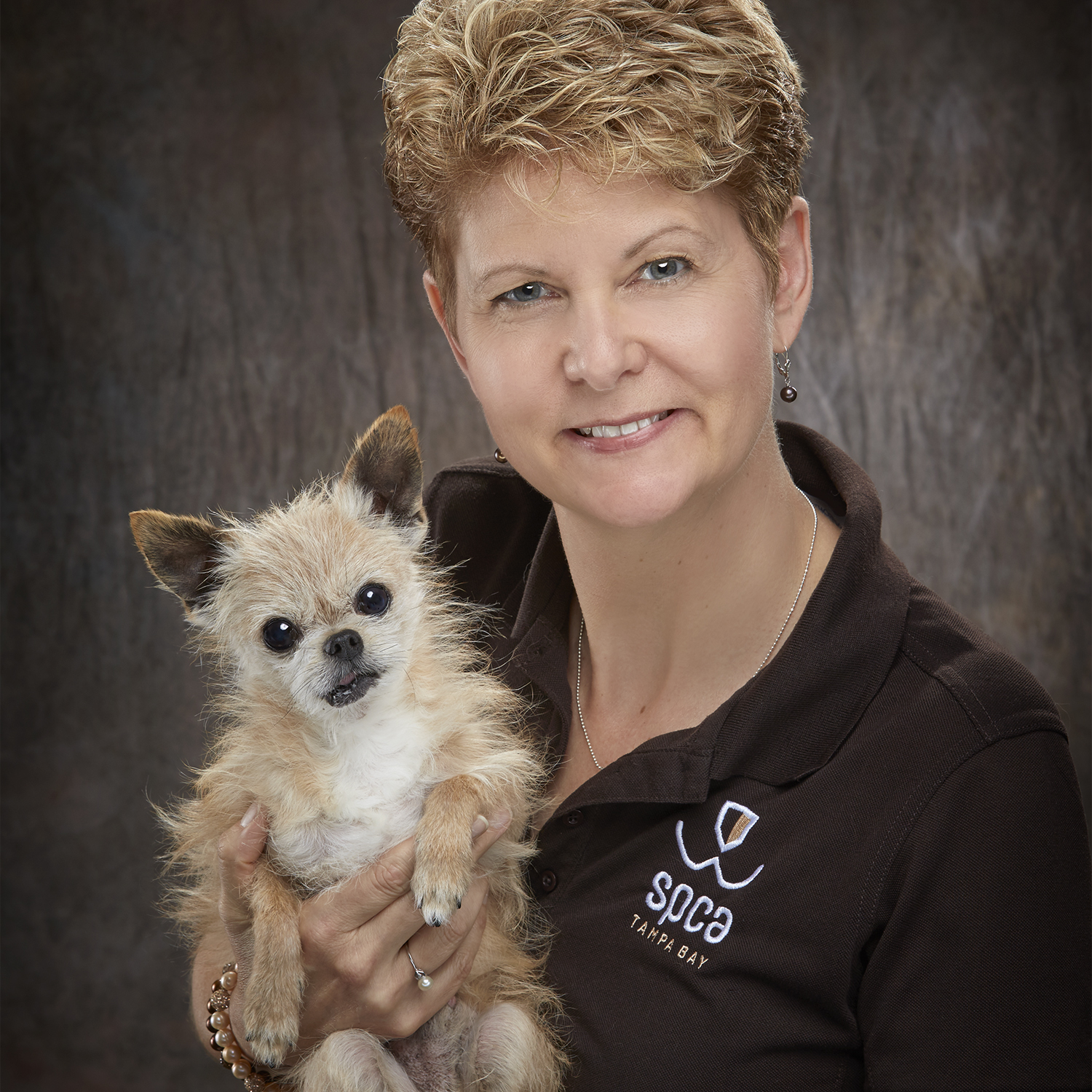
Martha Boden, CEO SPCA Tampa Bay
“I started to get a feeling for what a puppy distributor did,” Boden said. “And then as we were having these conversations, Chris started talking to me about Canine Care Certification and I thought, ‘Wait a second. This is not something that my world has been talking about at all. Like why are we not aware of this amazing thing that’s happening at one of the best veterinary colleges in the country?’
“And I realized again working through Chris and getting a chance to learn that it was still kind of in its early stages. And so I thought, okay, well, I want to understand more about it. I want to understand more about these standards. And I also want to understand, because Chris is bringing animals into my community, he knows something because he provides puppies to two of those six stores, he knows something about the world I live in. And I thought, if there’s an opportunity to partner with somebody who’s this closely involved with animals that are coming into my community, I should figure out what it is.
“So Chris brought, I think his entire management team to Florida. And we talked very frankly about, would there be an opportunity to partner and how it needed to be something that was a win for both of our organizations, and all of the people that we touch. And we just started brainstorming about what that might look like.
“And the first thing that came out of my COO’s mouth that I think made us all kind of stop on our tracks was she said, ‘You keep talking about a good breeder. Well, I’ve never seen one, because I don’t get called in when a breeder is doing a great job. My team gets called in when it’s a disaster. So forget any marketing that somebody might be doing. I’ve been there, I have walked through, you know, overwhelming facilities where, you know, there’s all kinds of horrific things happening all around us. That is all I know. So Chris and your team, you’re going to have to help me understand what a good breeder is.’
“And that really just opened the floodgates. So we basically all agreed, all right, let’s get to know each other. Let’s figure out who we are and what language we use and how we might be able to work together.
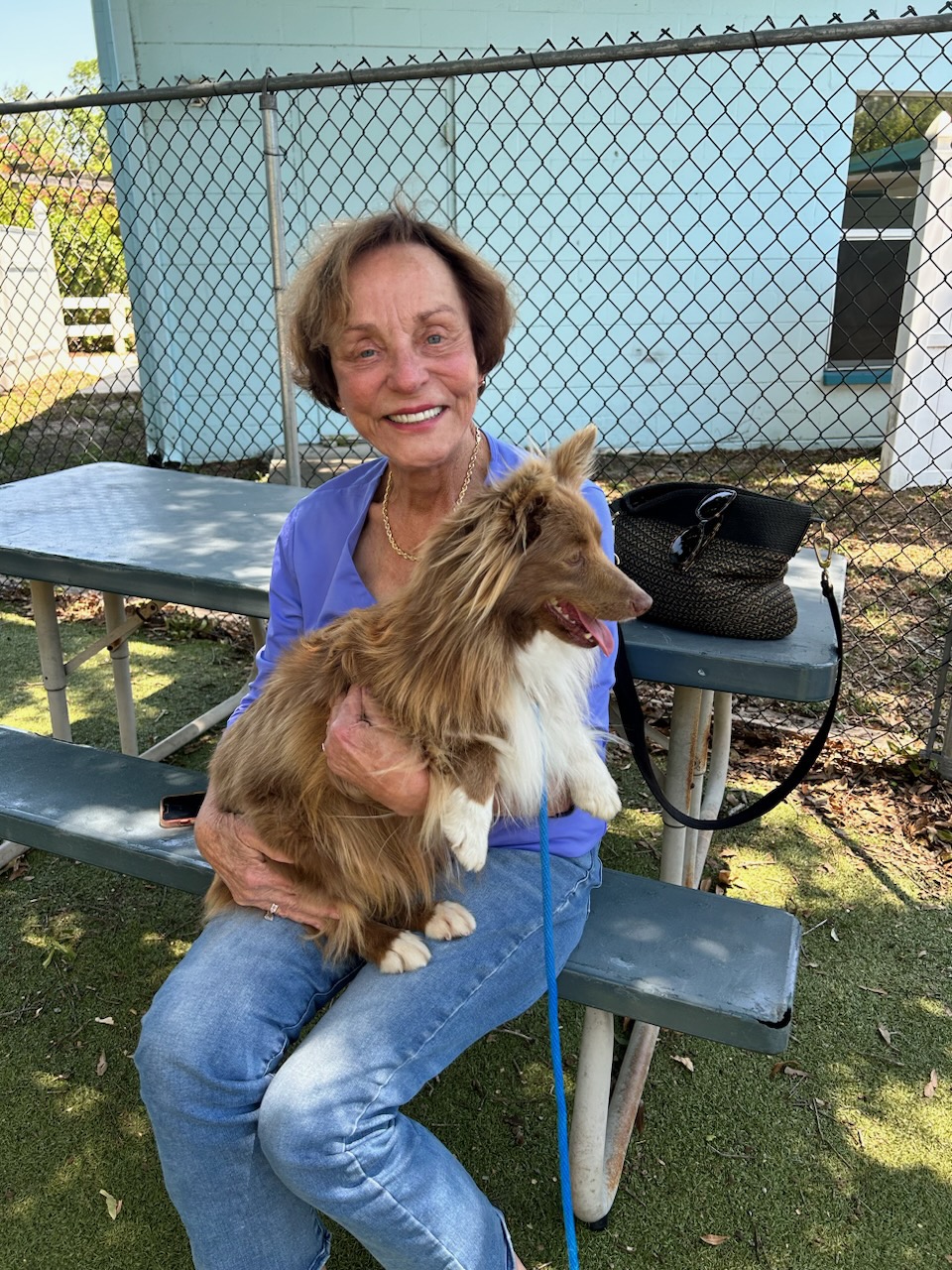 “And so we went into it with a very open mind, but not a whole lot of preconceived notions notions other than this kind of idea that, hey, wait a second, the Canine Care Certified Standards do require an adoption pathway for retiring adults and gosh, one thing we’re actually pretty good at is placing adult dogs with individuals that want to move them into their home. So that started a year -long journey.”
“And so we went into it with a very open mind, but not a whole lot of preconceived notions notions other than this kind of idea that, hey, wait a second, the Canine Care Certified Standards do require an adoption pathway for retiring adults and gosh, one thing we’re actually pretty good at is placing adult dogs with individuals that want to move them into their home. So that started a year -long journey.”
Listen in for the rest of this heart warming story about a truly staggering partnership to improve the lives of ALL dogs. Please take a moment to complete the survey Boden mentioned HERE.
603 — Purebred or Mixed Breed: Silken Windhounds Bridge the Divide
Purebred or Mixed Breed: Silken Windhounds Bridge the Divide
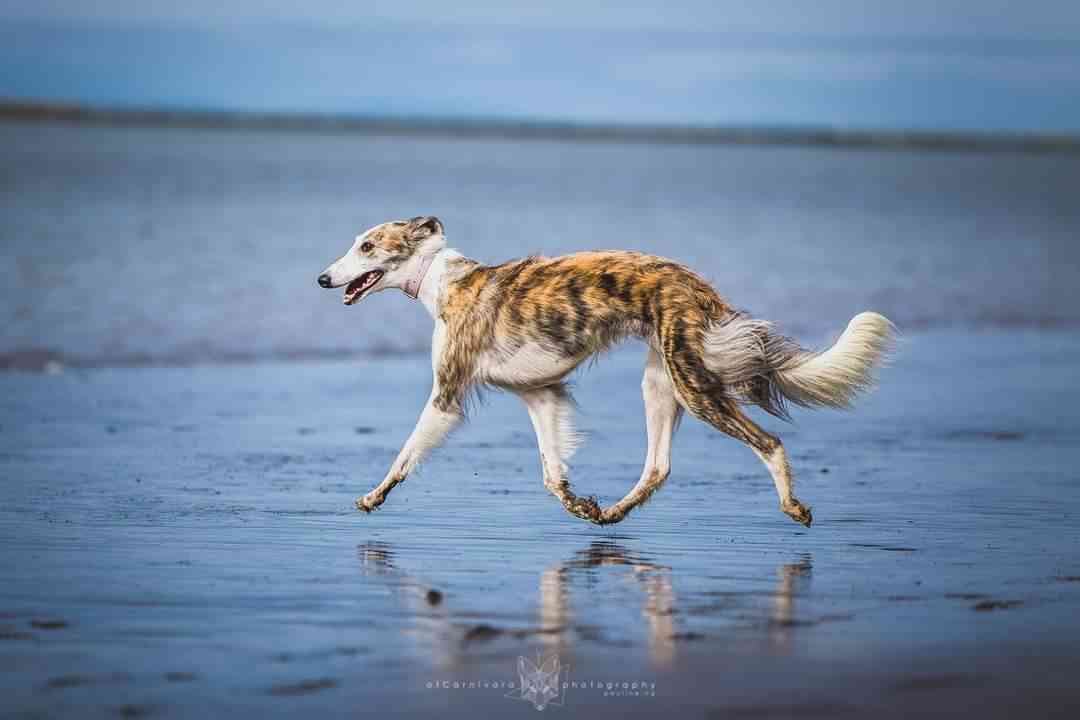
Silken Windhounds descend from lurchers (believed to be Whippet x Sheltie) and Borzoi.
Ashlynn Hill joins host Laura Reeves for a discussion of the Silken Windhound. These dogs appear to bridge the divide between preservation purebred dog breeders and the “fad” mixed breeds that make many preservation breeders tear out their hair.
A partial transcript of the conversation follows.
Pure Dog Talk is the voice of purebred dogs. We talk to the legends of the sport and give you the tips and tools to create an awesome life with your purebred dog. From showing to preservation breeding, from competitive obedience to field work, from agility to therapy dogs, and all the fun in between, your passion is our purpose.
– Welcome to Pure Dog Talk. I am your host, Laura Reeves, and we’re having these conversations. We had a conversation last week about the American bullies and kind of this concept that so few of the breeds that we know today were, as I say, burst from the head of Zeus, right? Most of our dogs that we know were created somewhere along the way. Some of them are more recent and there’s a conversation to be had about these created crosses, why they were created, what the goals are, what the history and the purpose of the crosses are, and how that progress is going into creating a whole new purebred dog.
So I have with me Ashlyn Hill, who is involved in Silken Windhounds. She says she came through the herding breeds to Silken Windhound pipeline, which I think is adorable.
Pure Dog Talk is proudly sponsored by Trupanion, medical insurance for the life of your pet. Trupanion can give you peace of mind knowing your pet is covered in the event of an unexpected accident or illness.
Even better, Trupanion can pay your veterinarian directly and has no payout limits. So you’ll never have to choose between what’s best for your pet and what’s best for your wallet.
And if you’re a breeder, you can join Trupanion’s free breeder support program and get a special offer to share with your puppy buyers that waves all the waiting periods.
So coverage goes into effect immediately.
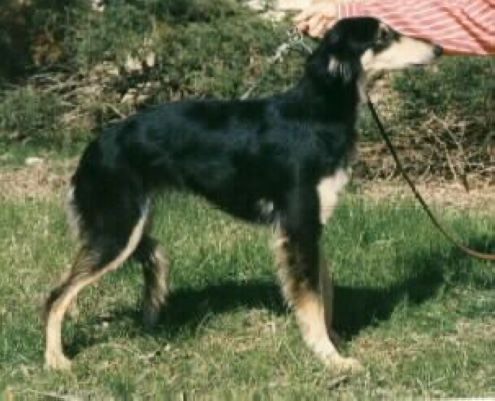
Kristull Amalie – LHW (1984) from Francie Stoll’s A litter.
Yeah. So Silken Windhounds, we’re going back to the very beginning. We’re looking at around the 1980s.
Our breed founder is Francie Stoll. She had a pretty extensive history in Borsoy before she decided to take on this project of making a new breed. So in the early 1980s, she actually got the first dogs that she would use to produce Silkens from Walter Wheeler. Walter Wheeler was well known in the Whippet community for having his long -haired Whippets.
So Walter Wheeler claims that he had, you know, purebred long -haired Whippets. You know, whether that is really true, we don’t really know. We, as Silken People, we say that they were lurchers. We very strongly believe that there were some Sheltie hiding back there because in Silken, we have CEA and MDR1, herding breed, you know. So that’s what our suspicion is. We call them our lurchers.
So Francie got several of these long -haired Whippets from Walter Wheeler. Some of them were in Whelp, and she used those to start making her own thing. I mean, it wasn’t until about 1985 that she says her first litter of Silken Windhounds were born.
This was when she had added in some Borzoi and she finally created the vision of what she was looking for. And really what she was looking to produce with these lurchers and adding the Borzoi and the little bit of the whippet history is that she’s looking for a medium -sized, very elegant, very easy sighthound. You know, just looking to fill that niche for something a little bit smaller, but not quite Italian greyhound sized. So that was really what she was just looking to produce.
And the D litter, the Kristull D litter, is what she says was her first production of Silkens. She made it. This is what she’s looking for. And she took that and continued to breed on from there.
So this is fascinating to me. Is she doing inbreeding, linebreeding, and how is she accomplishing or how is the breed today accomplishing? What is this? 30 years later, the consistency that you expect to see from a purebred dog?
Yes, there was a lot of linebreeding. Mostly there were studs used several times. You know, we’re talking upwards of like 7, 8, 9, 10, 11 times. We’ve got dogs being used. So it was primarily a lot of linebreeding on line breeding in the beginning. But eventually, we were able to create enough diversity to we’re sending Silkens out to Europe. We’ve got Silkens in Canada. We’ve got other breeders participating. You know, once it kind of got bigger than Francie, that’s when, and this is, you know, only the late 90s. That’s when we’re starting to add more.
We’re creating the breed and we’re able to take this and really just continue to breed on to what Francie has produced. And I really think that very early on, they were breeding true. You know, you look at a very early picture of a silken windhound and I can look at that even as a project dog and say,
“That looks like a silken.”
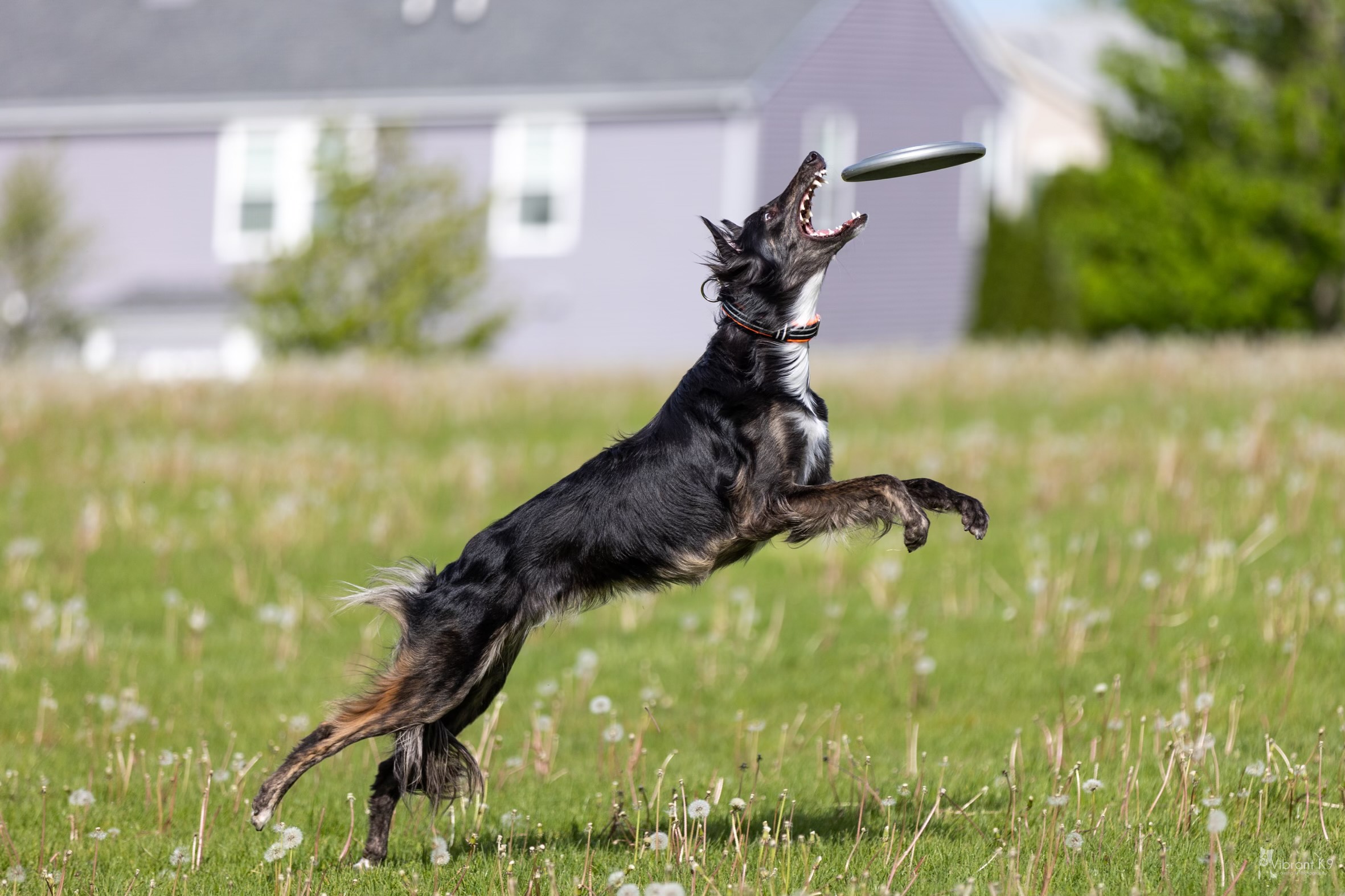
Most Silken Windhound enthusiasts enjoy competing in various sports with their dogs.
And so what makes a silken windhound its breed? So the ones that I’ve seen, I’m kind of like, “Is that an ugly Borzoi? What are we doing?” Right? So talk to me about what makes them their specific breed. What is their breed type?
Yeah. So I think what makes a silken a silken is that size -wise they should be, and typically are, much smaller than a Borzoi. We’re talking about with the size slightly bigger than a Whippet, slightly smaller than a Borzoi. They have very long, easy to maintain coat. Personality -wise, they’re a little more human -oriented, a little more biddable, willing to work. We do have silken, there’s a range. So we have your more sight -hound typical silken where we’re talking like, not a lot of repetition, the training session should be short and sweet. And then we also have silken, and I’ve met several, I have a couple that are just like almost border collie -like, and they’re willing this to work, like just drill and drill and drill.
Interesting. So you see that herding bit coming through.
Yes. And it’s surprising, you know, how much that really seems to, even still, because Sheltie was only ever what was behind Walter Wheeler’s dogs. There has never been any direct cross with Sheltie to Whippet, to Whippet, to Borzoi, like that’s never been in the history of a silken windhound. So it’s just that little bit way back when, and it still really seems to ring true today.
A little bit goes a long way with those guys.
Yeah. Literally.
So you have a club, you have a parent club, yes?
Yes. We have the International Silken Windhound Society. This was founded in 1999. That is kind of where we started to lock everything in. So we’ve got the breed club that’s been produced. We’ve accepted a breed standard, and now we’re kind of really making things officially official.
And do you compete with your dogs in UKC, I think, yes?
Yes. Yep. So we gained UKC recognition or acceptance in 2011. That’s our primary venue for conformation. Some time in the last 10, 15 years.
Yeah. Okay. All right. That’s good. And is there a desire amongst your group of fanciers to compete at the AKC level? Is this something you expect to take forward and to FSS, miscellaneous, and work your way up?
Yes. Yes. Very much much so. I would say a very good chunk of exhibitors in the breed are hoping for AKC acceptance.
Listen in for the rest of this fascinating coversation….
602 – Responsibly Developing New Breeds… What Does That Look Like?
Responsibly Developing New Breeds… What Does That Look Like?
The facts are that all but a very, very limited handful of our breeds today have been created by mankind for some purpose. Companionship is a purpose. I would like to introduce you to the Toy Fox Terrier, for example. As society moves away from agrarian and hunter gatherer lives, companion breeds and even new companion breeds are more in demand than ever.
Society changes. And I think that when we talk about purebred dogs being living history, in some cases that history is still being made and there are different needs in today’s society than there were 100 or 200 years ago.
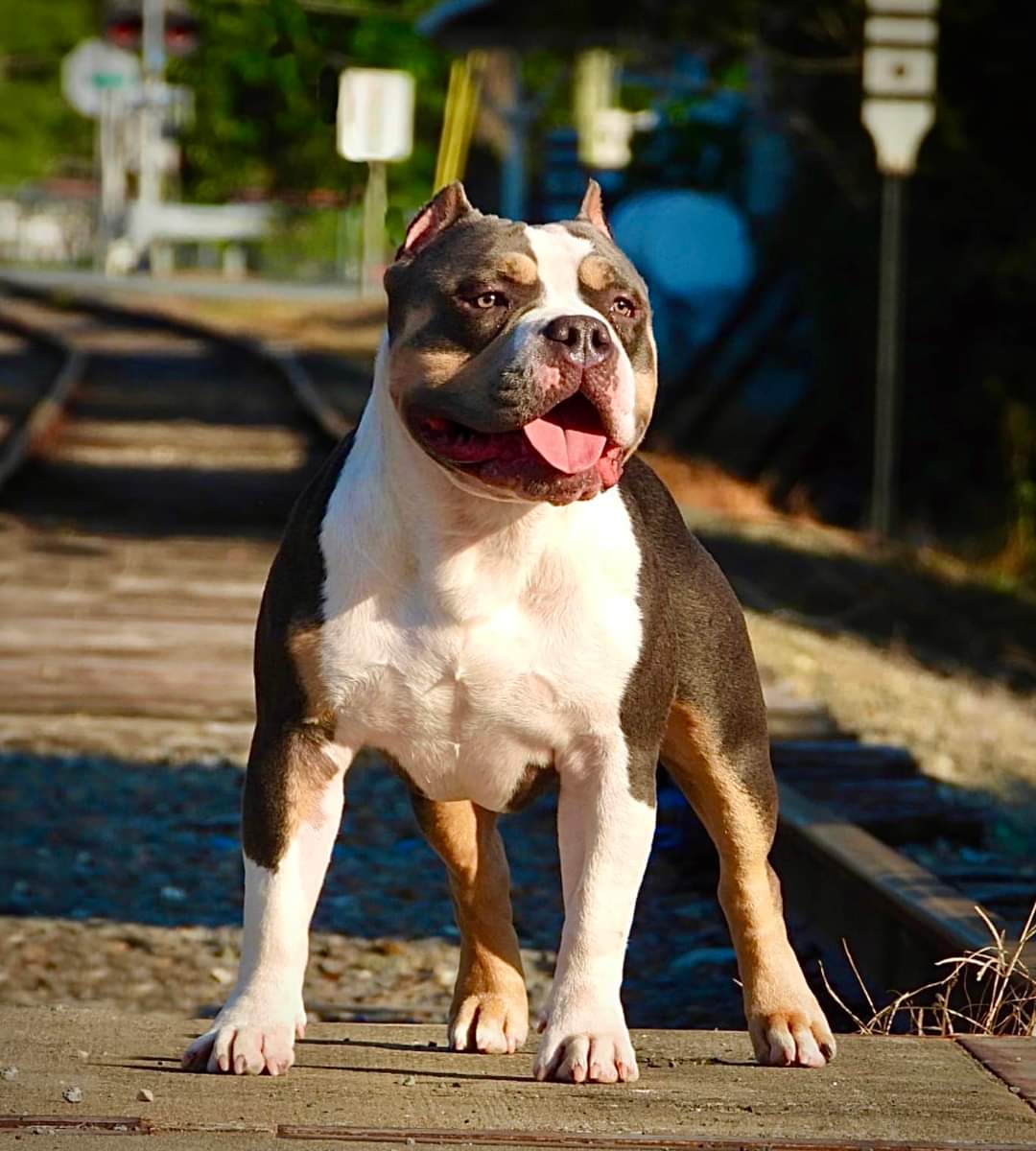
DASH DNJ HOP UWP URO1 EGRCH SB Knightfall SPOT
Join me for a conversation with Nikki Holcomb about the American Bully. Recognized by the United Kennel Club in 2013, Holcomb is leading the push to responsibly develop this companion breed with health testing, temperament testing, breeding goals, a breed standard and more.
“The American Bully is a companion breed,” Holcomb said. “A lot of people, when they see them, will immediately question that. They’re like, ‘Are you sure these are dogs in the companion group?’ Even when we’re at dog shows, we’re standing ringside and they’re like, ‘Are you sure at the right ring?’ And I’m like, ‘I’m absolutely positive.’ It’s surprising to people, I think, to see a big bulky dog beside a little bichon or a little toy poodle or whatnot, and they’re like, well, we just really don’t understand. And that’s valid.
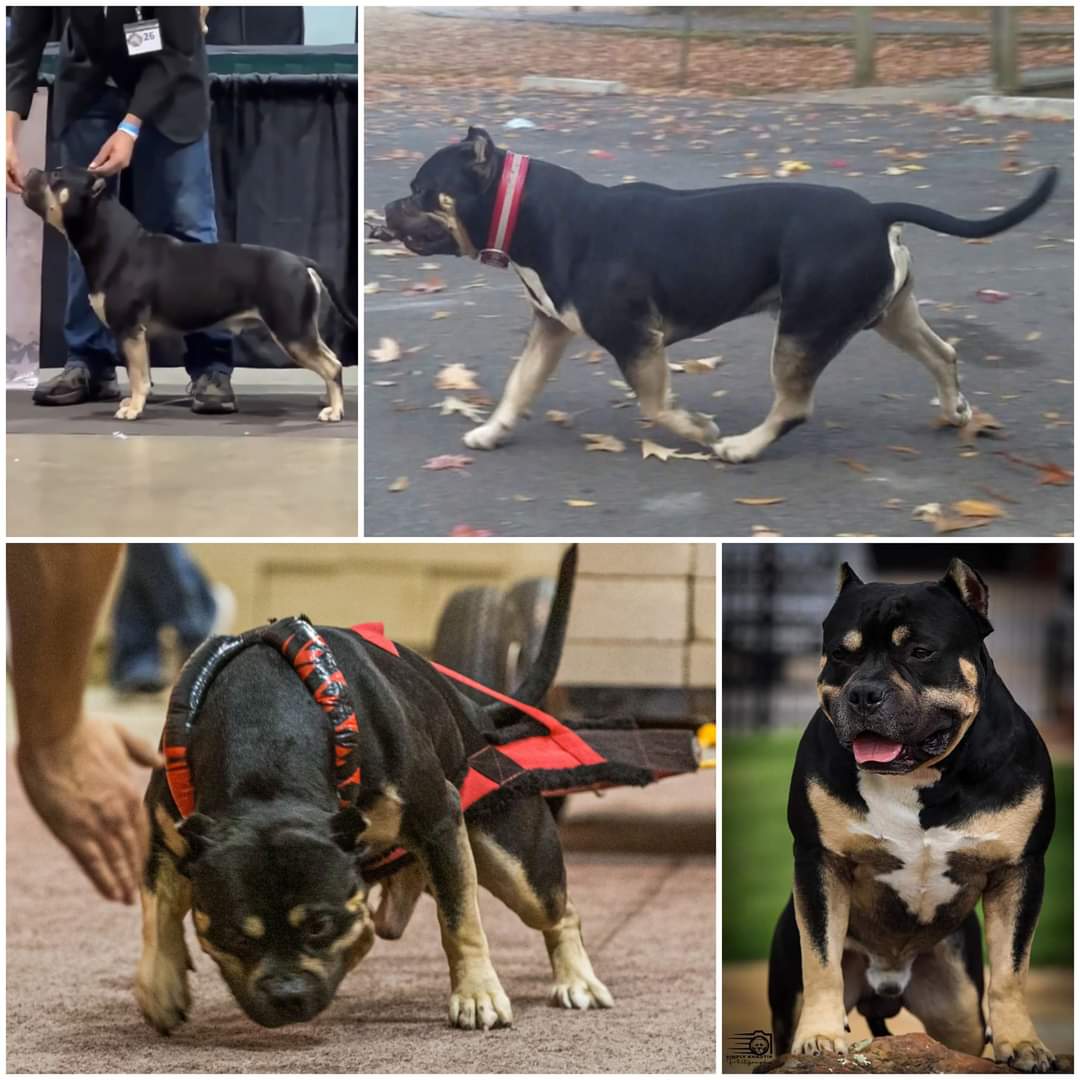
MBIS/MRBIS TDBIS MSDBIS VBIS R1 STAR3 RACEN URO1 AP2 VPA UWPO UGWPCH IC-GRCH INT-BCH DGCH ArK9s Noschitt Sherlock DNA-VIP NTD SPOT-ON
“But I think that American Bullies fill a really important spot. There are people out there that want to have a bigger dog, a little bit bigger than medium size, that can do all of the really fun sports, but they really don’t want a working dog. Or maybe they don’t want the attitude of a terrier, or they don’t want to deal with the baying of a scent hound or the quirks that come with the sight hound. You know, whatever it may be. But they want to sport dog. Or they want a dog that can go on three-mile hikes with them or go swimming at the lake and they’re like, well, do I get a small dog or do I just go with some of the things I don’t enjoy as much and I think American Bullies do fill that space really well.
“They’re very easy to train. They’re incredibly handler oriented. They’re absolutely in love with their people, to the point where they’ve never met a stranger. Protective is definitely not on their list. A lot of people will see them. They’re like, oh, they’re guardians. They’re 100% not guardians. They’re not going to protect you. That burglar coming in the house is their best friend. They’re super outgoing, they’re fun loving and they love to try everything you know, anything you could do. They’re excited to do it.”
“The official listing of founding breeds for the American Bully are the American Staffordshire Terrier, the American Pitbull Terrier, Old English Bulldog and English bulldog.
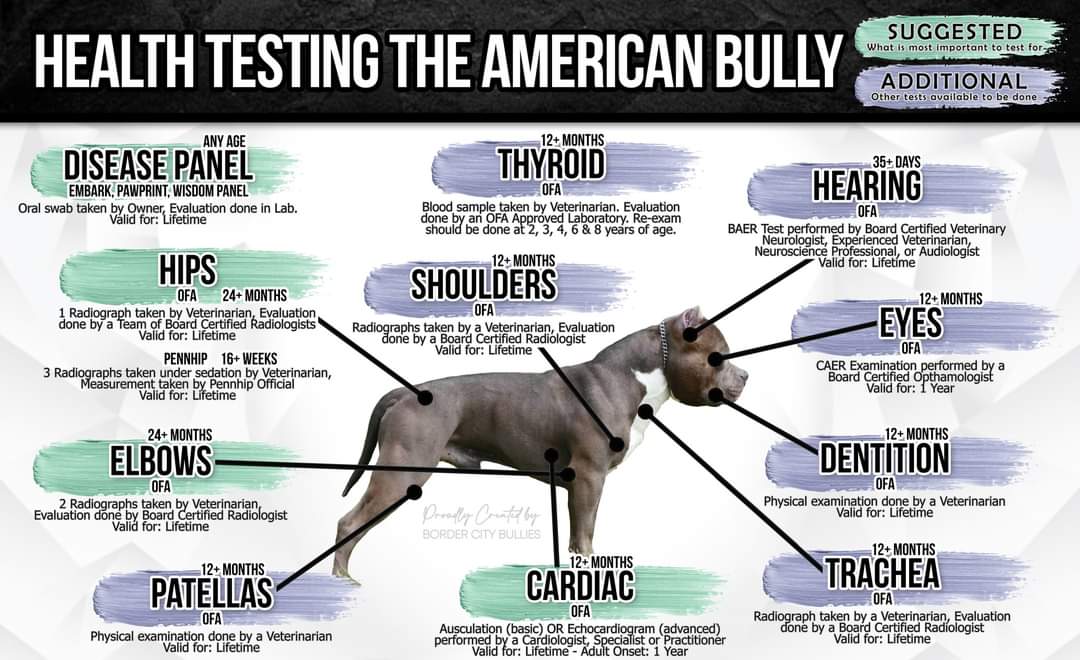
Health testing for the American Bully. Infographic by Anissa Shotbolt.
“I think they really took traits from each of these breeds and really focused on making a dog that could be calm enough and low drive enough to be with a young family, with young kids, or even a first time pet owner. Removing a lot of the dog aggression to the point where we do not want to see any dog aggression in American Bullies at all. We don’t want to see prey drive. You should be able to have your American Bully with anything and everything. They should be gentle with children. They should be biddable, easy companions. There shouldn’t be anything that makes them difficult for first time pet owner. These are really important traits for this breed that I feel like the founding breeds maybe fell a little bit short on.”
601 – Add Years to Your Dog’s Life with One Simple Step
Add Years to Your Dog’s Life with One Simple Step
Dr. Marty Greer DVM joins host Laura Reeves to discuss how every pet owner can add years to their dog’s life with the simple step of avoiding obesity.
“It’s a difficult conversation,” Greer said. “It’s difficult for veterinarians to bring it up. It’s difficult for clients. So all the way around, it’s a challenging process and we have to be very careful, as veterinarians, that we don’t insult anybody because our role is not there to be body shaming their pet, but rather to be that advocate for their pet’s best health.
“We know that dogs that are ideal body condition live 2 years longer,” Greer noted. This is based on a laboratory study of littermate pairs. One group was free fed as much food as they wanted over their lifetimes. The other group was fed 25% less. The dogs fed less lived two years longer than their littermates.
“We’re not going to convince people that they’re going to stop giving their dog treats,” Greer added. “I mean, that’s just not a practical thing for us to talk people into because that is their love language. That is the way that they communicate with their pet in a lot of realms. It’s easy to continue to give that love language of food to your pet, but to do it in a way that has lower calories. So instead of feeding them extra, you can do some simple things by changing the treats that you give.”
Dr. Greer’s top tips for avoiding obesity in pets:
- Weigh your pet routinely.
- Use your hands to feel the pet’s body condition (HINT: Watch the YouTube video of this pod for Greer’s demo of how she explains proper weight for each pet!)
- Trade out fruits and vegetables for dog biscuits.
- Limit “people” food or reduce amount fed at meals to compensate.
- Spayed and neutered pets need 25% fewer calories immediately.
- Increase activity.
- Plain Cheerios and ice cubes are fun treats for dogs. Get creative and make healthy eating fun for you and your dog.
600 – Mentors, Mentees and All the Love
Mentors, Mentees and All the Love
Welcome to Pure Dog Talk. I am your host Laura Reeves, and today is episode 600. Like holy podcast palooza Batman. There has been an awful lot of water under the bridge since November of 2016. If you haven’t, you should make a point to watch the Live@Five episode with Mary Albee from this month, where we talk about the creation of pure Dog talk. Everything from what to name it to her dragging me kicking and screaming into the role as host. It’s pretty epic conversation.
And for everybody who’s listening, just know that you can go to the website puredogtalk.com and the blog post will have links to a bunch of these things that I’m talking about today. I have lots of thoughts, but instead of droning on about how impactful this podcast actually is, which I know you know because I hear from you all on the daily, I want to dig into a topic that is front of mind for every single one of our listeners.
Not a day goes by in one of the, I don’t know, 9 million groups on dog book or in our own patrons group or somewhere. That there isn’t commentary about mentors and mentees and the relationships they’re in. I even touched on this in a conversation with Vicki Ronchette on her show Dog Prep School Facebook Live a few weeks back.
The fact is, for me, the most moving and powerful moments of the last seven years have been when random strangers tell me that pure dog talk and the work that we do here has served as their mentors. That pure dog talk, me as the host and all of our amazing guests – shout out to every single one of y’all – that we’re the reasons that they’re breeding dogs or showing dogs or participating in a club. And that veterinary voice episodes with Marty Greer of literally saved their dog’s life. That I, that I was their virtual mentor from afar, in a tiny, tinny voice over their smartphone.
So I wanted to dive into the concept of mentorship more in this epic moment of episode 600. This day represents a truly mind-bending amount of time and energy. Learning, growing, succeeding, failing. And I guess I’d like to use that as an avatar for really a larger conversation. Growing up this podcast, this community, this ever blossoming dialogue is in many ways analogous to the effort involved as both mentor and mentee in any relationship.
And as it turns out, the ability and willingness to share knowledge and accept the sharing of knowledge in a mentoring type relationship is not actually hardwired into the human brain. So I went searching for, you guessed it, some more insight and some more knowledge.
599 – Norwegian Elkhounds: The OG GPS Tracking System
Norwegian Elkhounds: The OG GPS Tracking System
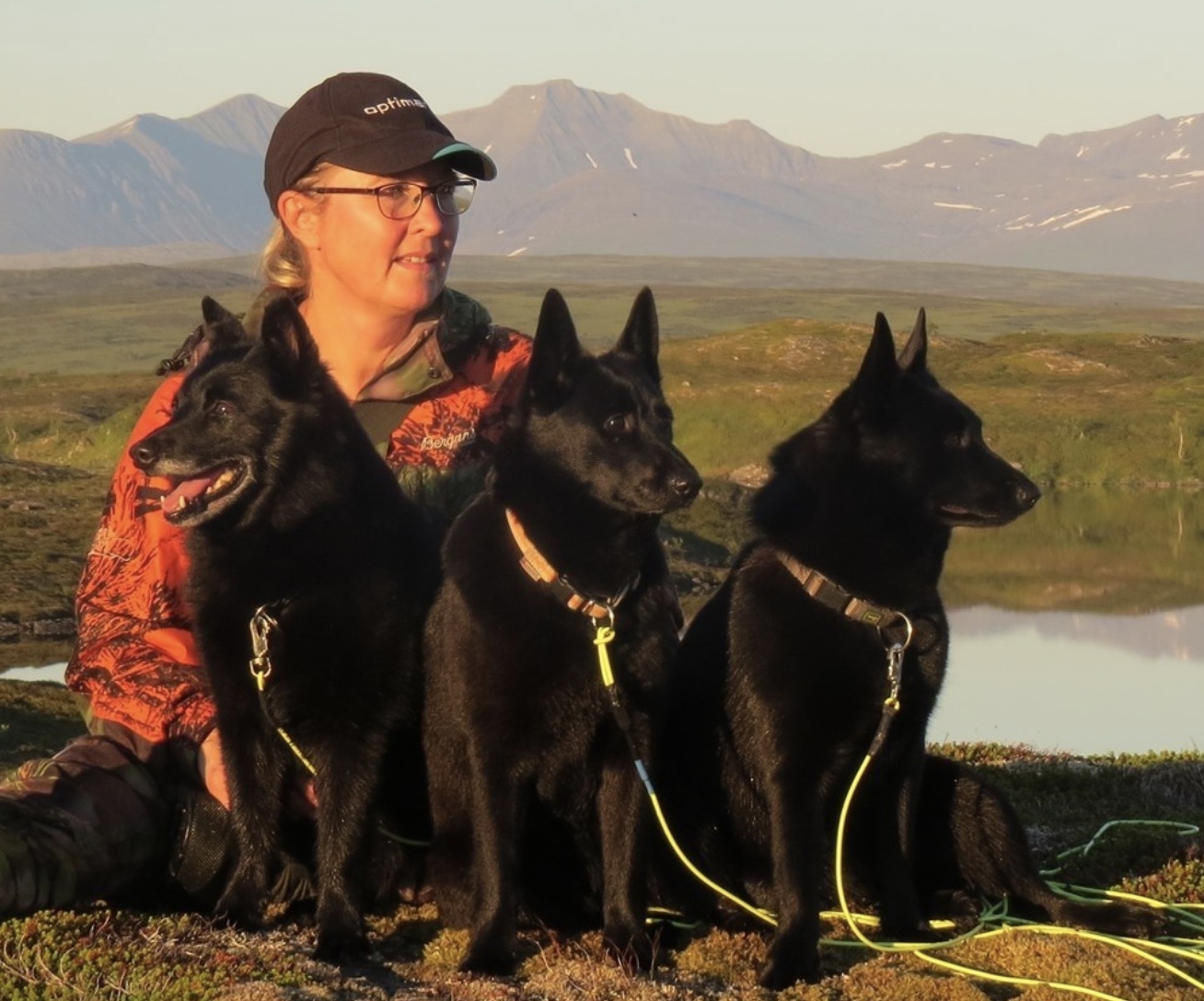
Kamilla Engen with her dogs. In Norway, Grey and Black Norwegian Elkhounds are recognized as separate breeds.
Kamilla Engen, Norwegian Elkhound breeder, judge and moose hunter in Norway, joins host Laura Reeves for a Love the Breeds discussion of this ancient hunting breed. Engen judged the breed’s US National Specialty in May.
Per the Norwegian Elkhound Club of America, The Norwegian Elkhound is bold and energetic, a hardy gray hunting dog known for his lush silver-gray coat and dignified but friendly demeanor.
In appearance, a typical northern dog of medium size and substance, square in profile, close coupled and balanced in proportions. The head is broad with prick ears, and the tail is tightly curled and carried over the back. The distinctive gray coat is dense and smooth lying.
As a hunter, the Norwegian Elkhound has the courage, agility and stamina to hold moose and other big game at bay by barking and dodging attack, and the endurance to track for long hours in all weather over rough and varied terrain.
The durable Elkhound is among Europe’s oldest dogs. They sailed with the Vikings and figure in Norse art and legend.
You Get the Dog You Deserve
“(These are) excellent family dogs,” Engen said. “We also enjoy our nature. And it’s the perfect companionship if you are hiking, going in the mountain. I always walk my dogs and so they are good off leash. I always said that you get the dog that you deserve. If you want the dog to get back to you, you have to start with that. It’s a training. Of course. But if you start early and make it positive to come back to you, yeah, of course (they come when called). Because the ability that makes it an enormously great hunter is the ability to cooperate with the hunter.
“We have two kinds of forums of hunting that use these dogs. The one is the most usual is loose. You let the dog loose and you have a GPS tracker on it so you can see where it is and you can also see when it stands still and you can hear the barking. Then you have contact with a moose.
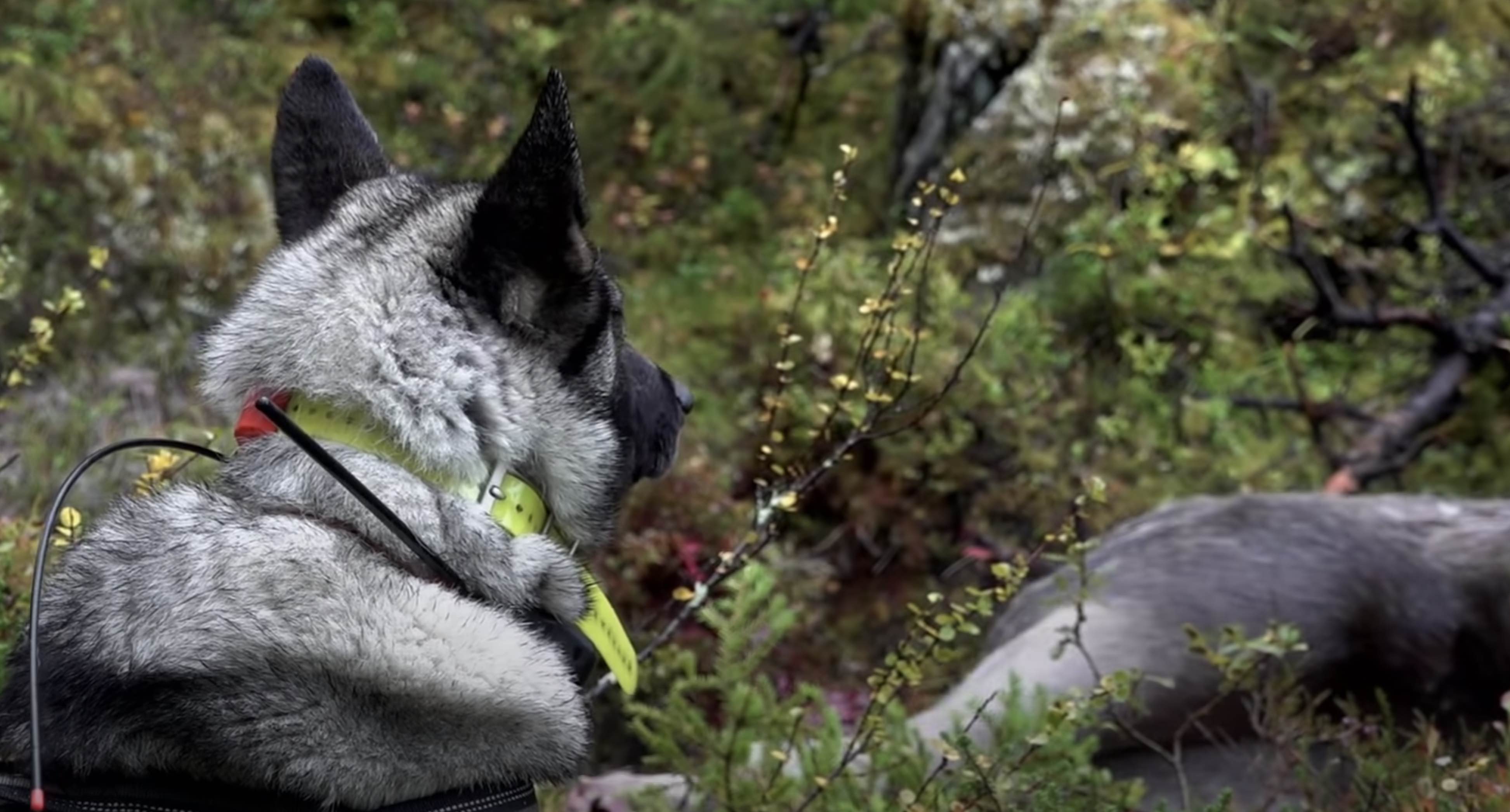
This Norwegian Elkhound tracked down a wounded moose that was hit by a car so it could be humanely dispatched.
“The other one is with a very long leash, 5-6 meters. And let me just explain a little bit why we do that in Norway. Norway is a tiny country compared to the United States and we have distinct areas that we are allowed to hunt. In these areas you can hunt a certain number of mooses. OK and these dogs? They run far. And the and a moose doesn’t always stop (in the confined area). So, if you have small areas, it’s very helpful to have a leash because then you can control it a lot more and you can search a whole area.
“They locate the moose from a quite a long distance. They are incredible, their ability to do this. Then they located, they run over to it and hopefully they are able to get the moose to turn around towards them. To defend themselves. This is an old, old instinct that moose have from wolves and bears. And then the dog barks. From old times before the GPS trackers, the hunter hears that noise. And that was their GPS.”
598 – Basset Fauve de Bretagne: Old Breed is New to AKC Miscellaneous
Basset Fauve de Bretagne: Old Breed is New to AKC Miscellaneous

Nick Frost, AKC Judge and Hound Authority
Nick Frost, AKC judge and hound specialist, joins host Laura Reeves to talk about the charming Basset Fauve de Bretagne. Better known for his Petit Basset Griffon Vendeen breeding program, Frost was involved with the Fauve in England in the late 1970s.
The Fauve, as the breed is commonly called, entered AKC’s Miscellaneous competition for the first time in July of this year. They have previously competed in Open Shows and participated in the Foundation Stock Service.
According to the Basset Fauve de Bretagne Club of America, “The Basset Fauve de Bretagne is truly an old French Hound, tracing back to the 1500’s when Francois I had a pack of Breton hounds which he hunted regularly.”
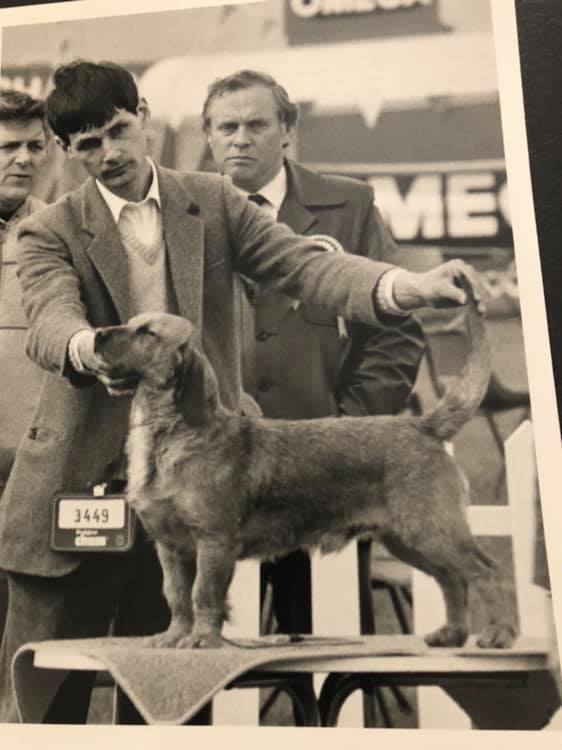
Frost with Merrick, Varon Aymeric at Dehra born in quarantine at Ryslip kennels.
Fauves, like many European breeds, were nearly lost due to the World Wars and had to be reconstructed from just a handful of breeding stock, Frost said.
In France, the breed is a rabbit hunting hound and the French are very proud of the breed’s hunting ability. They are kept as pack hounds in their native land and as a result are very good with other dogs.
“(The Fauves are) very sweet tempered,” Frost observed. “I found them more so even than the (PBGV). I never experienced a fight with my Fauves.”
These short-legged hounds carry a short, hard, dense wire coat, less profusely furnished than the distant cousin the PBGV. Minimal, low maintenance grooming is required for Fauves with correct coats.
“It’s a breed that needs activity,” Frost noted. “Like all pack hounds, they just need a companion. They are great with kids. The breed is a bit more people-focused than many scent hounds.”
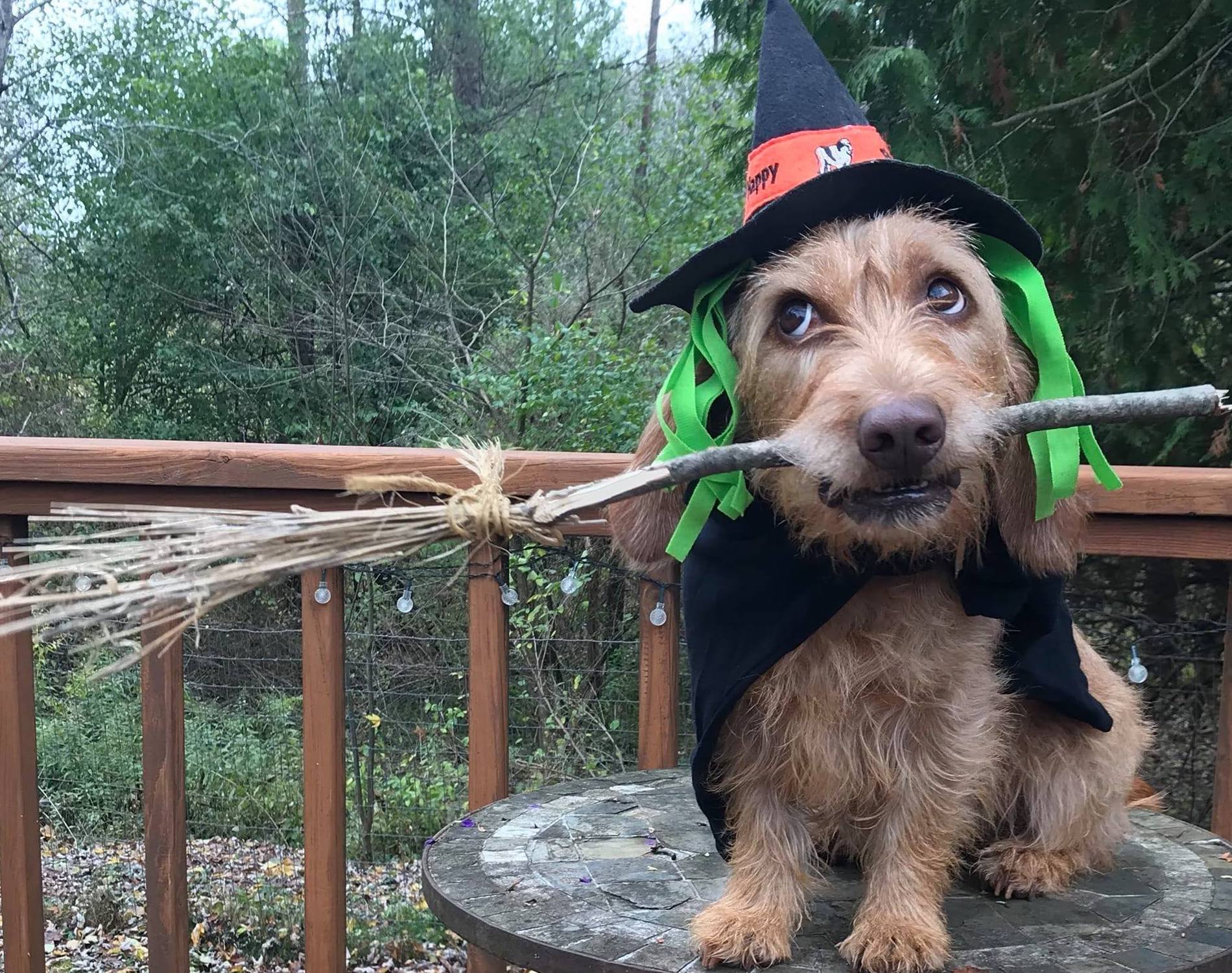
Fauves are generally biddable and people oriented.
“This is still a hound,” Frost said. “It still can be “deaf”, you can’t trust them to come when called every time. They are still being hunted and worked full time in Europe. So that prey drive is still close to the surface.”

